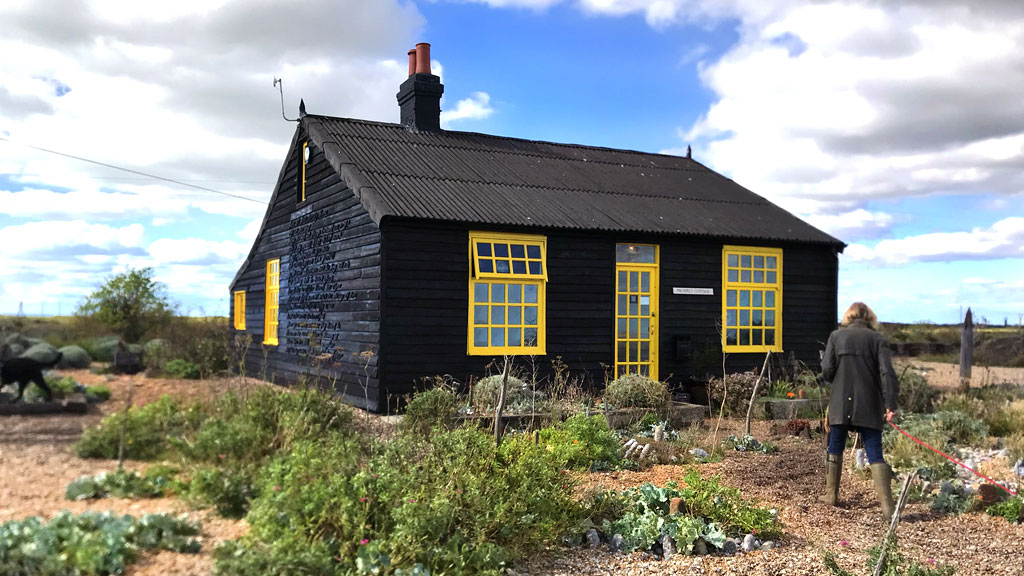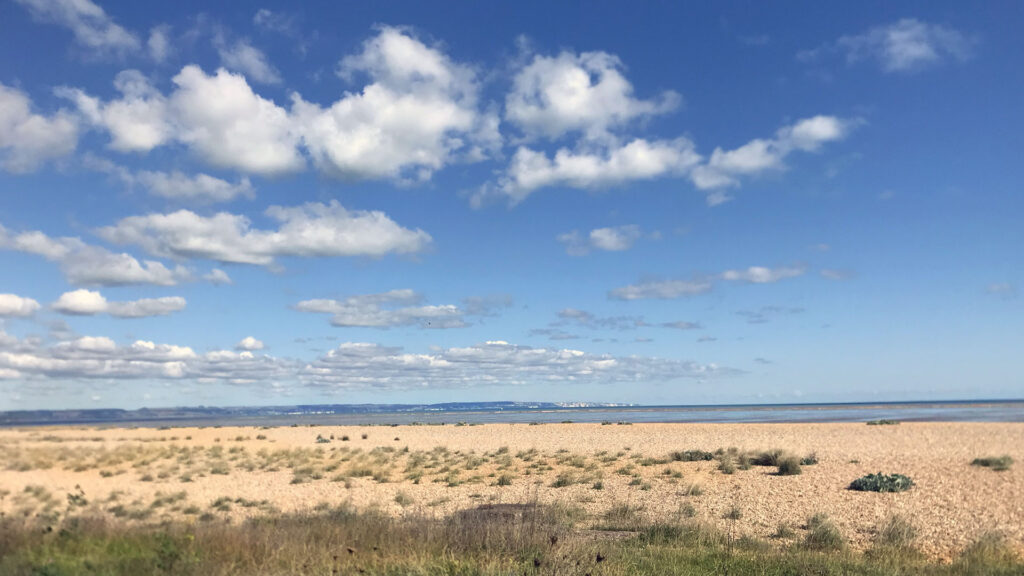
My recent trip to the United Kingdom was so incredible that hearing Viv Albertine speak wasn’t even the greatest moment of my trip. Viv Albertine! Of the Slits!
I am going to jump around a bit in the timeline of the trip to highlight my favorite moments. I was in the UK from Sunday to Sunday, September 22 to September 29. On my first day, I saw Steve Wynn at the Walthamstow Rock n’ Roll Book Festival and Viv Albertine at the George Tavern in Shadwell. From Monday to Wednesday, I visited my friends Mick and Anne in Edinburgh ( my first ever visit to the city). On Thursday, I visited my dear friend Sarra in lovely Muswell Hill, then headed to Finsbury Park to see the first of two Prolapse shows. Friday, I headed to Brighton to see Prolapse again, and Saturday our group road-tripped to Dungeness to visit Derek Jarman’s Prospect Cottage. Sunday I was back in London for a last day of good food and an extensive Tate Modern visit. Oh, and I witnessed the debut of Widget, a band featuring members of Big Joanie and All Cats Are Beautiful.
A Day in Dungeness
I think of Derek Jarman as a worldbuilder extraordinaire. Before his life was cut tragically and horrifically short by AIDS in 1994, he never stopped creating films, books, poems, and paintings— his last film, Blue, came out the year before he died — and he was equally adept at transforming raw spaces.
From 1969 until 1979, he lived in a succession of rudimentary studio spaces, all of which were situated on the Thames riverside. (Now fully gentrified, the neighborhood was then a warren of crumbling warehouses and disused wharfs, with less than 5,000 residents.)
The first of these was a raw space where Jarman erected a greenhouse to insulate himself from the raw wind while he was sleeping. He called the loft “more like a stage set than an artist’s studio,” and it was here that he began to make Super-8 movies documenting the queer community of artists, writers and big personalities that flourished in these liminal spaces of the city. The last of these spaces, in Butler’s Wharf, is now marked with a blue plaque as a tribute to Jarman’s transformative output. (Glitterbug, a seamlessly edited compendium of his Super-8 home movies, occasionally shows up on the Criterion Channel.)
In 1986, Jarman was struck by the alien beauty of coastal Dungeness while on a location scouting trip with collaborator Tilda Swinton. On impulse (and thanks to a small inheritance), he purchased a fisherman’s cottage facing the English Channel. (On a clear day, you can see the white cliffs of Dover in the distance.)
As with his early lofts, Jarman wasted no time stripping the space back and transforming it. Inspired by the harshness and desertlike beauty of the ness, he painted the cottage’s exterior pitch black, enlivened by electric yellow window frames. A lifelong gardener, he began to teach himself how to create a garden that could thrive in the austere Dungeness shingle. After some fits and starts, he created a low-slung garden, scrubby but persistent, that transformed through the seasons (harsh winters and hothouse summers); in his diary he wrote:
When I came to Dungeness in the mid-eighties, I had no thought of building a garden. It looked impossible: shingle with no soil supported a sparse vegetation. Outside the front door a bed had been built — a rockery of broken bricks and concrete: it fitted well. One day, walking on the beach at low tide, I noticed a magnificent flint. I brought it back and pulled out one of the bricks. Soon I had replaced all the rubble with flints. .. They looked great, like dragon’s teeth. My journey to the sea each morning had purpose. … At the back I planted a dog rose. Then I found a curious piece of driftwood and used this, and one of the necklaces of holey stones on the wall, to stake the rose. The garden had begun. I saw it as a therapy and a pharmacopoeia.
DErek JARMAN
I’ve wanted to visit Prospect Cottage, now a National Heritage site, for years. Everything aligned on this trip: Since a number of us would be assembling for Friday night’s Prolapse show, we planned to set out early on Saturday for a coastal visit.
Even the drive to Dungeness a leisurely two-hour trip is picturesque. We drive through towns like Battle (the actual location of the Battle of Hastings), Rye and Romney Marsh. We pass through villages and narrow roads shaded by rows of trees; we lope along rolling hills and coastal towns.
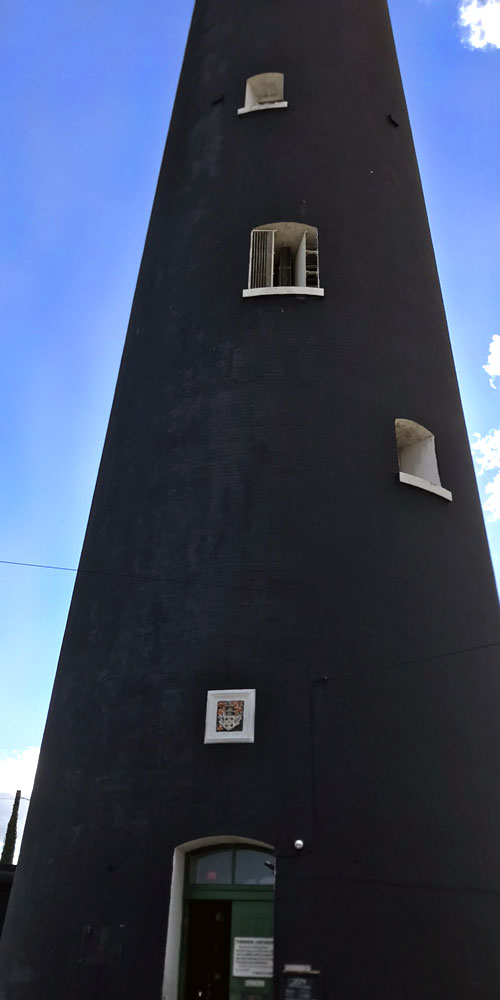
At last the rolling hills give way to a rocky and flat expanse of beachfront. So flat that the sky looked endless and the clouds looked deceptively low, like you could pluck them right out of the ether. And there, across a narrow two-lane road, is Prospect Cottage.
Our garden visit falls during a transitional time between summer’s riot of color and fall’s muted tones,. Even so, the garden is dotted with bursts of yellow and red and every shade of green possible. The sculptural flotsam from Derek’s beach walks — driftwood, colored stones, flints, jagged metal curled into whorls, old anchors and other refuse of the seafaring trades — punctuate the orderly garden space as a reminder of his watchful and benevolent oversight.
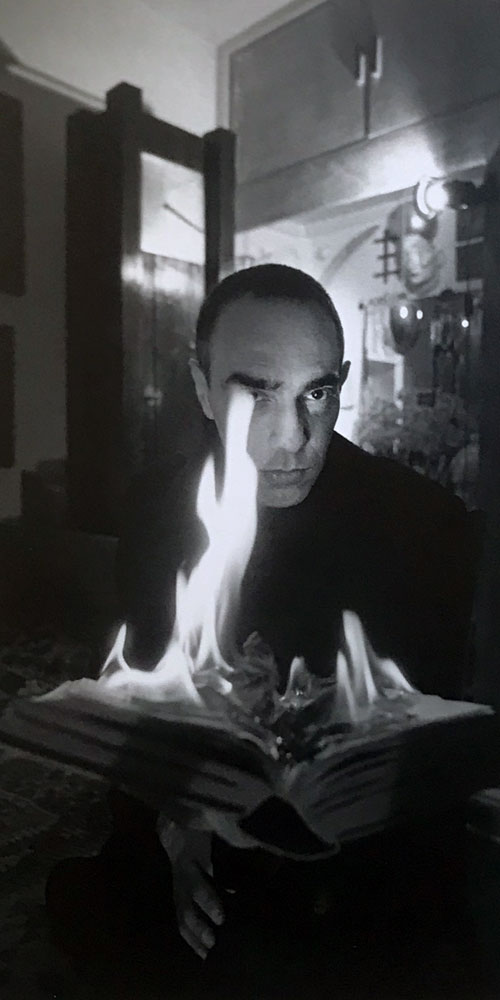
We peek respectfully into the cottage. A student researcher is reading a book in the sun room. The front door has a QR code (a depressing modern convenience) and a brief note: “Been out fishing. Now I’m sleeping — shhhh!” I stand for a few minutes, trying to process the enormity and joy of finally visiting this incredible place so infused with Derek’s memory. (And that of Keith Collins, who lived with Derek for the last decade of his life and tended to the Cottage after Derek’s passing.)
After a marvelous lunch at the Dungeness Fish Hut (alas, oysters are sold out), we take a brief loop around to view the historic lighthouse before heading westward again. This time we are stopping at St. Clements Church, where Derek and Keith (fondly dubbed “Hinney Beast” by Derek) are buried under a 600-year-old yew tree.
From there, we head to the tiny town of Rye for the last stop on our Derek Jarman tour. “Derek Jarman: From Soho to the Fifth Continent” pulls together art and memories of Derek from artist Jane Palm-Gold and photographer Derek Ridgers. (Ridgers’ photo of Derek with a burning book really plays up Jarman’s “white witch” aspect.)
Romney Marsh is referred to as the “fifth continent” due to its unique landscape and density of wildlife and plants; it is home to roughly 1/3 of all plant species in the UK. One of the wall captions listed some of the plants to be found in Derek’s garden, including:
- Poppy
- Foxglove
- Borage
- Dog rose
- Yarrow
- Mugwort
- Crocus
- Sea kale
- Show drops
- Valerian
- Hyacinth
- Rosemary
- Yellow Gorse
- Celandine
- Lily of the Valley
- Forget-me-nots
- Sempervivum
- Nasturtium
- Mustard
- Cornflower
- Red Valerian
- Celandine
From Derek’s diary: “I would like anyone who reads my books to try this wildness in a corner. It will bring you much happiness.”
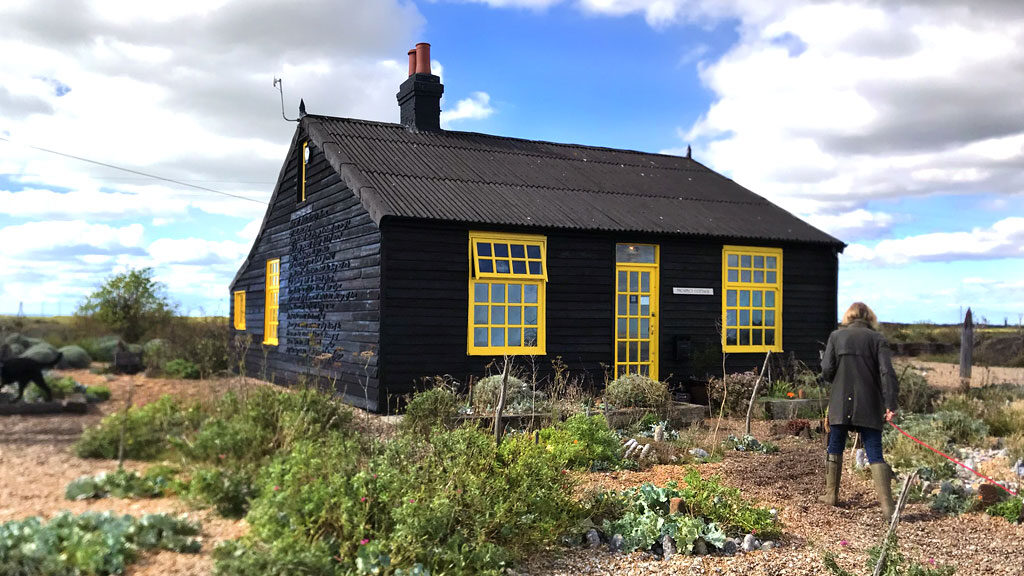

Prolapse in London & Lewes
My Instagram handle @visaforviolet is borrowed from the Prolapse song “Visa for Violet and Van.” I became an instant fan of the band in 1994, when I worked with their manager, Tony Fisher, and he recommended that I investigate them. I ended up putting out a split flexi of their song “Psychotic Now” with the final print issue of my zine, Warped Reality, in 1996. (His Name is Alive also contributed their song “My Canada.”)
I am reasonably sure that Prolapse never, ever, EVER imagined they would be playing shows more than 30 years after they jokingly decided upon the worst band name they could envision (years before Google search) with the collective aim of being “the most depressing band ever.”
And who would have predicted that a group of us would travel from far-flung places (Leeds, Brighton, Manchester, Providence) to see them on multiple occasions? This particular trip, I see two of their 3 shows — at London’s New River Arts Studio with Kylie Monologue, and the following night at Lewes Con Club with the great Chop Chop. (The final show is at Saturday’s Paris PopFest, which looks ace.)
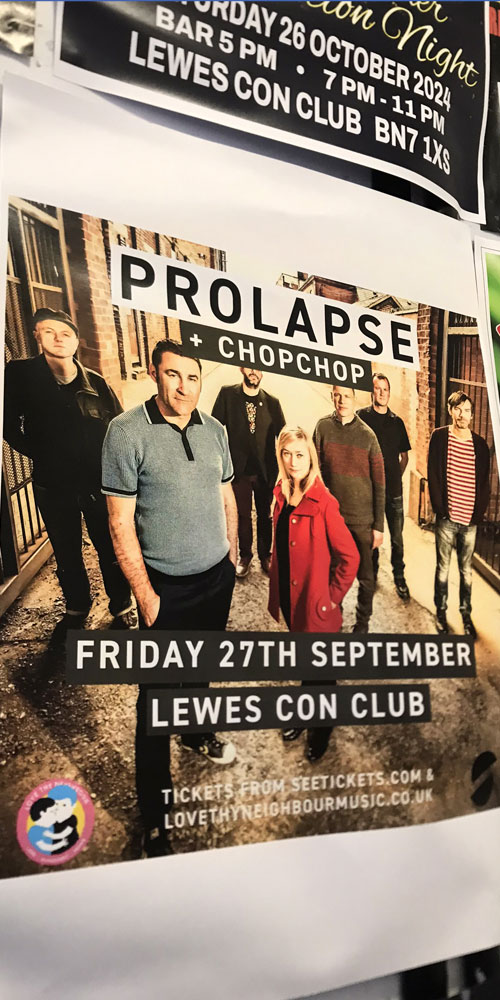
The Lewes show is notable for a few reasons. Better sightlines, for one. Also, the Lewes Con Club is an actual membership-based social club that doubles as a music venue. And it is in Lewes, which is adorable. Tobi Blackman, who has booked the show, also tour manages Kristin Hersh (among other luminaries). We take a selfie and text it to her. There is a lovely garden space out back where we pose for our “Prolapse pals assemble” group shot. (Thank you, Tobi, for the photo!) Afterwards we (lovingly) heckle the band during their soundcheck.
Seeing two Prolapse sets back to back is such a joy. Mick jokes that we can expect the “same old shite,” but that is both accurate (we do hear some “classic” Prolapse tunes) and inaccurate (there are some ace new ones mixed in! Look for a new album next year-ish). They honestly create my favorite racket in the universe and also happen to be fantastic people. I feel very lucky. Thank you, Prolapse.

Edinburgh and Other Areas of Outstanding Natural Beauty
In 1997, Susan Curran and I road-tripped to Glasgow to see Prolapse (time is a flat circle, etc.) and Arab Strap at King Tut’s Wah Wah Hut. (We all sang along to Prolapse tunes on the jukebox at nearby Nice n’ Sleazy.)
But it was my only Scottish experience until now. My friends Mick and Anne moved to Edinburgh roughly a decade ago and have been trying to get me to visit ever since. Things didn’t align until this trip, when I decided I to take the train and spend a few days with them in Leith. I love taking the train and the added benefit of the LNER to Edinburgh is that it hugs the coastline and passes through multiple “Areas of Outstanding Natural Beauty” along the Northumberland coast. It’s stunning coastline and you can really see the landscape change to old growth forest fairly quickly as you close in on Scotland.
Mick and Anne live in Leith, a deepwater port that is now also home to a thriving whisky industry. Once crime-ridden and rough, it is now a lively neighborhood that’s easily accessible to Edinburgh’s “Old Town” center by a modern tram system connecting Edinburgh to the airport and other crucial destinations.
Even if the weather is less than optimal, Leith is massively charming. Sea air and an echo of an industrial past — what’s not to love? And as Mick and Anne point out to me, you can see the infamous Trainspotting flats (now fully gentrified) from their balcony. (We later walk past the Brutalist property on our way to the Little Chartroom for dinner.)
I am in Edinburgh for 36 hours, give or take. It’s not enough time to visit some of Mick and Anne’s favorite spots like Portobello Beach or the National Gallery, but I get a solid sense of the city’s layout and see some of the city’s most iconic vistas, particularly the astonishing views of Arthur’s Seat and Edinburgh Castle from the National Museum of Scotland’s rooftop garden. We walk along the Grassmarket and up to the castle’s ramparts, then back down the steep stairs along the craggy side of the castle. It’s beautiful and I really get the sense that Edinburgh is carved out of ancient topography that’s been preserved and put on display. It’s so different from, say, San Francisco, where the hills have been fully conquered by development.
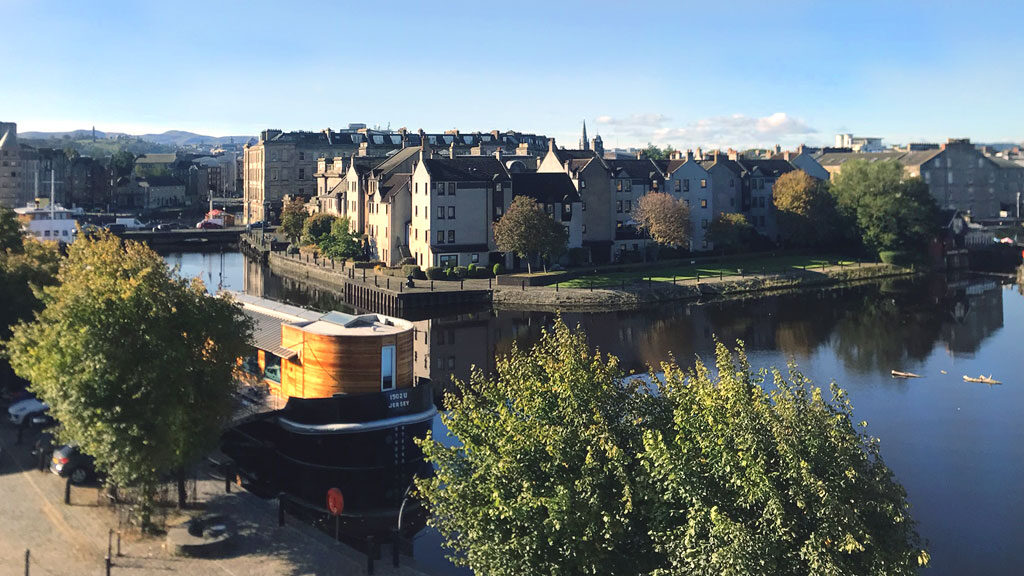
Best Bites
I didn’t necessarily have ONE single meal that stood out as “the best,” but I had a lot of remarkable bites. These included:
- Tipo Edinburgh: Vanilla and strawberry soft serve
- Brat Shoreditch: Anchovy flatbread with garlic and chives; olive oil ice cream with grilled strawberries; perfectly chilled Negroni
- St. John Bread & Wine Spitalfields: Marmalade “rolly cake” with cold custard
- Kusaki Brighton: Tempura oyster mushrooms with cold soba noodles and wasabi aioli
- Plimsoll Finsbury Park: Cheeseburger with fried potatoes and aioli
- Dungeness Fish Snack Shack: Crispy potatoes


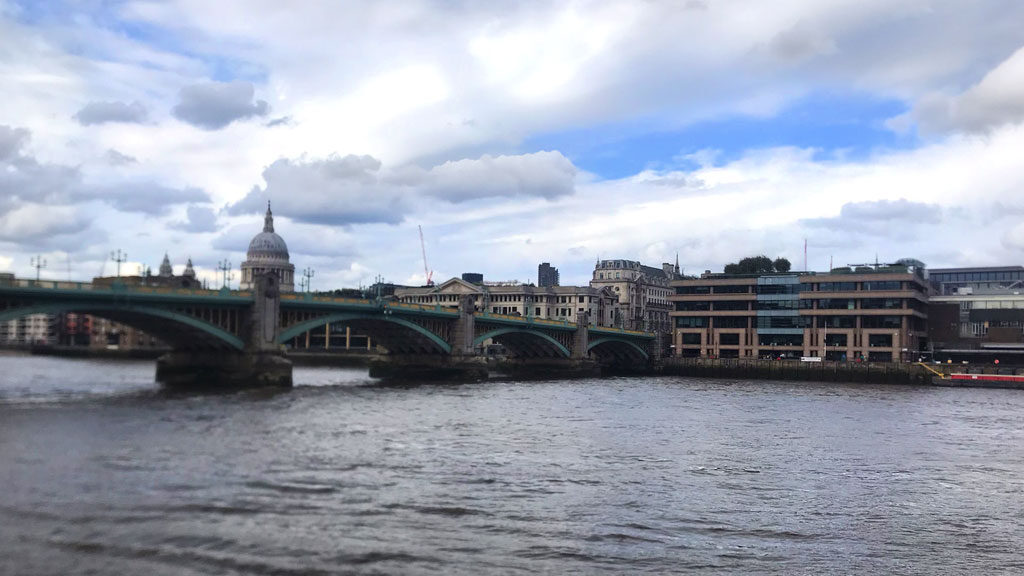
More Music
I saw a good amount of music throughout my trip. On Sunday, my first full day in London, I saw Steve Wynn of the Dream Syndicate in conversation with Stewart Lee. Steve read from his new memoir and talked about his long career in music. He really emphasized how much he has grown into his role as a collaborator and how he’s learned how to have fun with music in a way that he didn’t when he was younger. (Which also coincided with the band’s meteoric rise and major label entanglement — the band certainly has its share of growing pains.)
Later on Sunday, I meet up with my friends Sally and Michaela to see (or more accurately, hear) Viv Albertine talk at the historic George Tavern. It’s so jammed and hot that we end up decamping to the back garden for pizza (surprisingly good) and G&Ts. We do hear manage to hear Viv, and she talks about those crazy early days when the Slits were vilified for being so feral and “unladylike” (a bitter reminder of how massively hidebound Britain was in the 1970s) — Ari Up was even stabbed not once but twice! (She was only 14 when she started in the band.) Viv also talked about how she’s practically a hermit these days, but briefly discussed her next book, which is a primer on how to be creative.
My last hurrah in London is going to see the debut show of Widget at the lovely Shacklewell Arms. I meet up with Kate Dansette and her friend Pearl joins us. (Pearl knows everyone there and has a seemingly encyclopedic knowledge of female-fronted post-punk/riot grrl-adjacent bands.) Estella DJs before Widget’s audaciously fun set — syncopated, sly punk-funk with fantastic harmonies and a perfect vocal foil in singer Kyle (All Cats Are Beautiful).

